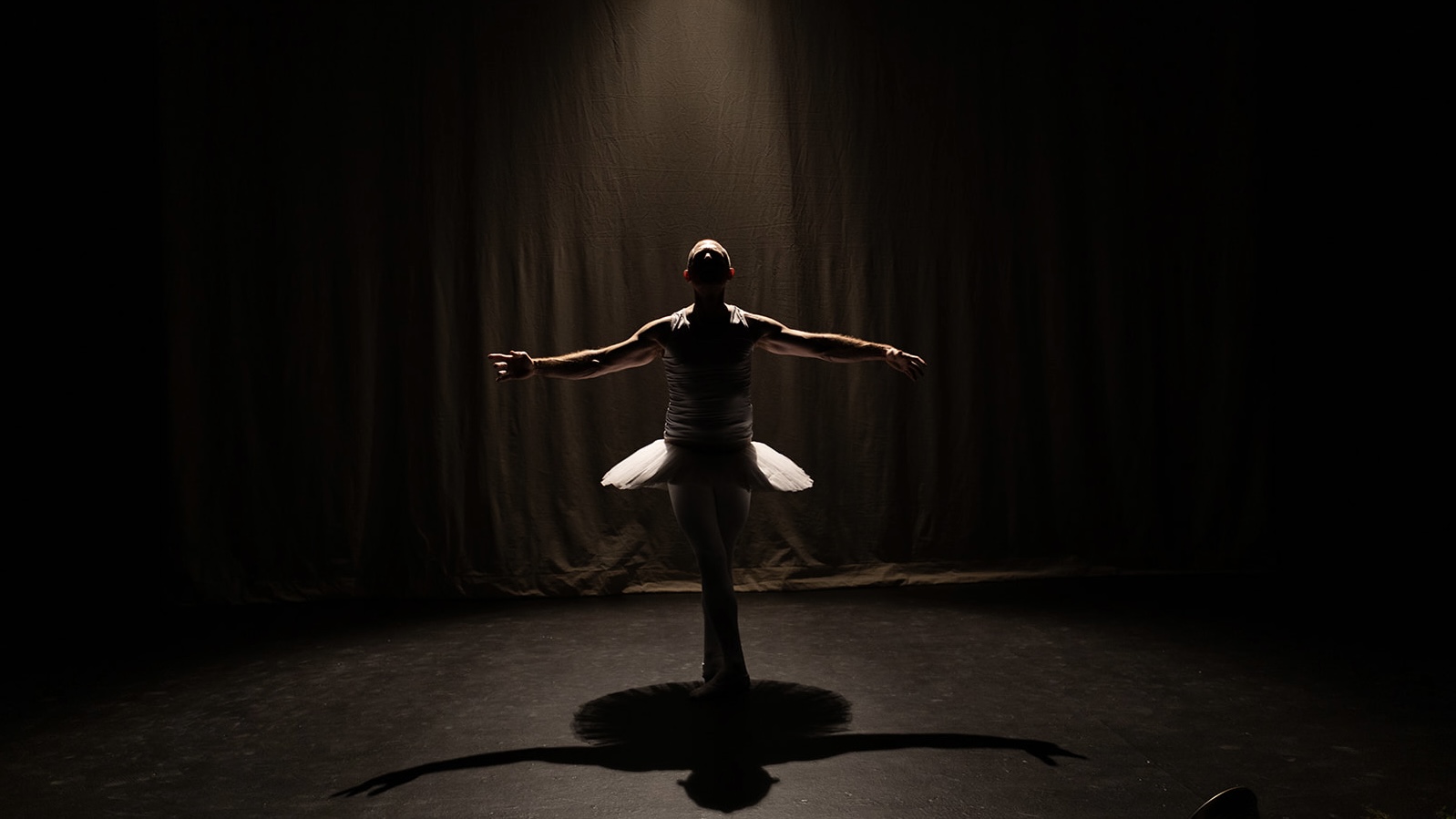Certainly! Here’s the text with line breaks removed so that it’s structured in full paragraphs:
We sit in a square, framing the stage. The chairs have more than an arm’s length between them. This pre-show space feels sparse yet heavy with excitement, maybe even expectation. We collectively wait for the premiere of Manfred Fischbeck’s performance of I Think Not. Fischbeck, artistic director of Group Motion Dance Company and cornerstone of the Philadelphia dance community for over forty years, is about to present an improvised score that is the outcome of his participation in Deborah Hay’s Solo Performance Commissioning Project.
Fischbeck enters wearing all black. His movement is calm, practically meditative. I barely notice the shifting of his feet as he travels. He stirs and floats his arms through the air. It looks like his cells are simmering at a slow boil, never exploding or spattering. Even as he passes in front of me, he doesn’t disturb or displace space. Nor does he make eye contact with me. I can’t distinguish the quality of his gaze, his eyes distorted behind his eyeglasses. Fischbeck’s head, neck, and fingers pulse and sway like a field of wheat blowing in the breeze — a dance of gentle subtlety. His spatial progression, tracing the perimeter of the square and returning to the corner where he entered, washes over me: I feel placid, even sleepy.
What if where I am is what I need? Fischbeck both ponders and poses this question in the program notes. Many believe that improvisation in performance falls short when it becomes stagnant. An improviser must make choices to create change; he or she must find refreshing new ways to navigate space, shift dynamics, and surprise the audience. Fischbeck does not avoid stagnancy and its negative connotations but, rather, redefines it. He is with his whole body at once in the moment before us. His approach, patient and holistic, reinforces improvisation as a practice and process rather than as an outcome or culmination.
Images from memory and experience seem fleshed out in the latter half of I Think Not. Lunging in a warm, circular pool of light, Fischbeck plays an imaginary violin—no, banjo, or some kind of string instrument. His fingers seem to realize the specificity of this instrument for the first time as the rest of his body viscerally reverberates. With a few final variations on this repetitive task, Fischbeck transitions into speaking. He asks the audience, “John?” Then again, “John?” He doesn’t get upset (like, Where the hell is John?), but he also doesn’t abstract the text beyond its implication of calling out for another human being. Then, “Elizabeth?” I wasn’t expecting John to raise his hand or Elizabeth to stand up, but I wonder, had my name been John or Elizabeth, if I would have felt an adrenaline rush.
The music, designed by Fischbeck, gently interrupts the silence part way through the solo. Its melodic ease almost makes me forget that the music is not composed, but instead, improvised and generated by a “sound beam — a device with which movements trigger computerized sonic responses.” Fischbeck has had a long history of scoring his work with this technology, which City Paper critic Deni Kasrel called “mighty intriguing” in 1996.
But 1996 was a whole sixteen years ago. Aged eleven, I spent ’96 feeling pretty sure that music groups like Enya and Deep Forest were about as artsy and experimental as they came. It only took a few years before I found Orinoco Flow, and the like, laughable… just plain kitsch. In a world where the genesis of ideas and their expiration dates have such tiny gaps between them, I marvel at Fischbeck’s persistence and longevity. I Think Not seems to challenge jittery young artists in ceaseless search for their most contemporary selves to slow down and ask themselves, What if where I am is what I need? I am grateful for Fischbeck’s and Hay’s generous curiosity within a field that many would assume they should have, by now, already mastered.
Also on the program were: Lung Ta, a quartet choreographed by Fischbeck to music composed by Andrea Clearfield, SCHWARZER TOD AND THE USELESS EATERS, a collaboration between video artist and writer Quintan Ana Wikswo, composer Andrea Clearfield and choreographer Manfred Fischbeck, and Strata, a re-mount of a piece by internationally renowned artist Carol Brown (New Zealand), commissioned in 2001.
A bit of I Think Not backstory:
In the Solo Commissioning Project 2011, by world-renowned choreographer and teacher Deborah Hay, participating choreographers and movers from all over the world commissioned Hay’s solo I Think Not for their own adaptation, individually coached by her. Hay’s work gets to the root of “presence” in performance. Through research into the body, performers become aware of their “cellular bodies,” alive and sensing. Hay is known for work that is gentle, imaginative, and yet rigorous (participants must sign a contract to practice this solo daily for three months).
For more than four decades Manfred Fischbeck has presented experimental dance in Philadelphia. Having studied theater, philosophy, and literature in Berlin, he was instrumental in lifting the boycott there on the works of Bertolt Brecht through the premiere of In the Jungle of the City. His interests turned toward dance when he began studying with Brigitta Herrmann (who would have danced a solo on tonight’s bill, but was injured) and Hellmut Gottschild of Gruppe Motion Berlin, a modern dance company that evolved from the Mary Wigman School. After Fischbeck joined the company, the three relocated to Philadelphia as Group Motion in 1968.
Group Motion’s Spring Fest, Christ Church Neighborhood House, March 15th & 17th, 2012. No further performances.
http://www.youtube.com/watch?v=RpbOrw6l8_s
http://www.deborahhay.com/about.html
http://groupmotion.org/






